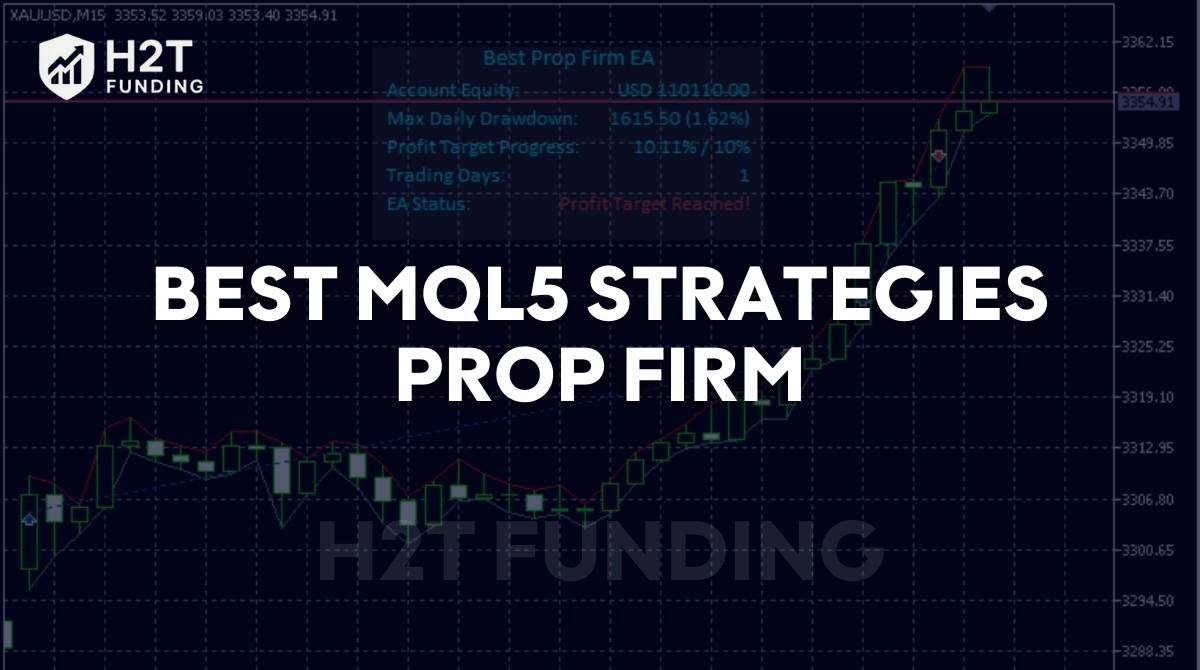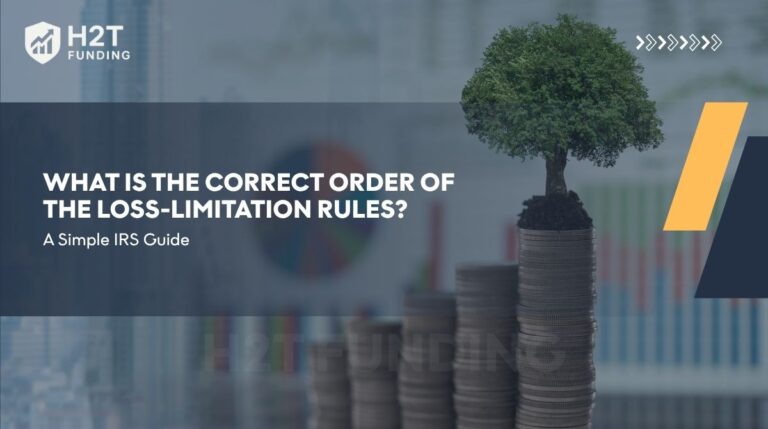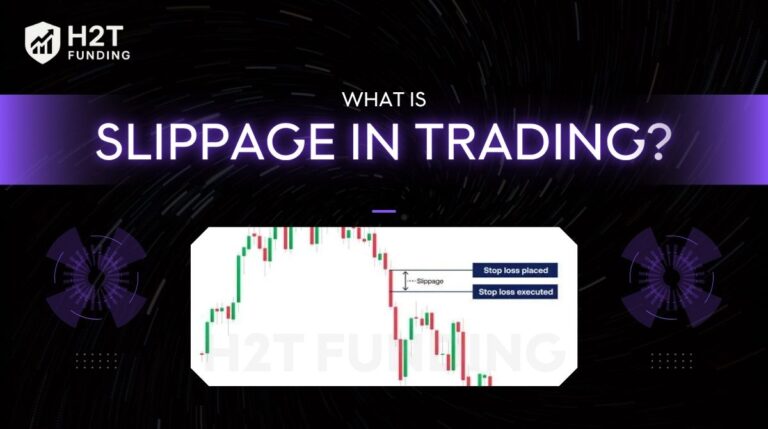The best MQL5 strategies prop firm traders rely on require more than just a profitable algorithm; they demand a system built for survival. You might have an Expert Advisor (EA) with a brilliant back test. However, it could still fail the evaluation if it wasn’t designed to handle the strict drawdown and consistency rules that proprietary trading firms enforce.
The key to success lies in adopting MQL5 trading robots for prop firms and other algorithmic strategies tailored for this environment. These approaches must prioritize capital preservation and consistent gains over high-risk methods. If you optimize the right strategy, an EA can transform from a simple tool into a powerful ally, helping you navigate the challenge with greater ease and discipline.
Key takeaways:
- Best MQL5 Strategies prop firm: Grid trading strategy, Trend following strategy, Scalping strategy, Martingale strategy, Breakout trading strategy,…
- Prop firm rules are key: EAs must respect max drawdown, daily loss limits, and consistency. High-risk strategies like Martingale usually fail.
- Choose the right strategy: Trend following, swing trading, and selective scalping work best; avoid HFT, arbitrage, and grid trading.
- Backtest thoroughly: Use MQL5 Strategy Tester in MT5; optimize for low drawdown and risk, not just profit.
- Built-in risk management: Best MQL5 strategies for prop trading include stop loss, take profit, daily drawdown, and fractional risk per trade (0.25%-0.5%).
- Select prop firm carefully: Use MT5-friendly firms that allow EAs, like FTMO, The5ers, FundedNext, Funded Trading Plus.
- Test real EA performance: Many market EAs fail the prop firm rules; focus on strategies with proven backtest and forward test results.
1. Why MQL5 strategies matter for prop firms
MQL5 (MetaQuotes Language 5) is the powerful programming language behind the MetaTrader 5 (MT5) platform, allowing traders to create sophisticated Expert Advisors (EAs), custom indicators, and scripts. When trading for a prop firm, the stakes and rules are fundamentally different from managing a personal account.
In personal trading, you define your own risk tolerance. For a prop firm, you must operate within its strict risk framework, which typically includes:
- Maximum Drawdown: The largest peak-to-trough decline your account can sustain.
- Daily Loss Limit: A cap on how much you can lose in a single day.
- Profit Targets: Specific gains you must achieve to pass the evaluation, which must be met without violating any drawdown rules.
An MQL5 strategy automates your trading, removing emotion and ensuring disciplined execution 24/7. In a prop firm setting where consistency is rewarded over high-risk wins, this is a massive advantage. A well-coded EA can be programmed to automatically respect every rule, like drawdown limits and position sizing, making well-developed, funded MQL5 strategies an invaluable tool for passing a challenge.
2. Prop firm rules to keep in mind
Before deploying any MQL5 strategy, you must thoroughly understand the firm’s specific rules. While they vary, most reputable prop firms enforce the following:
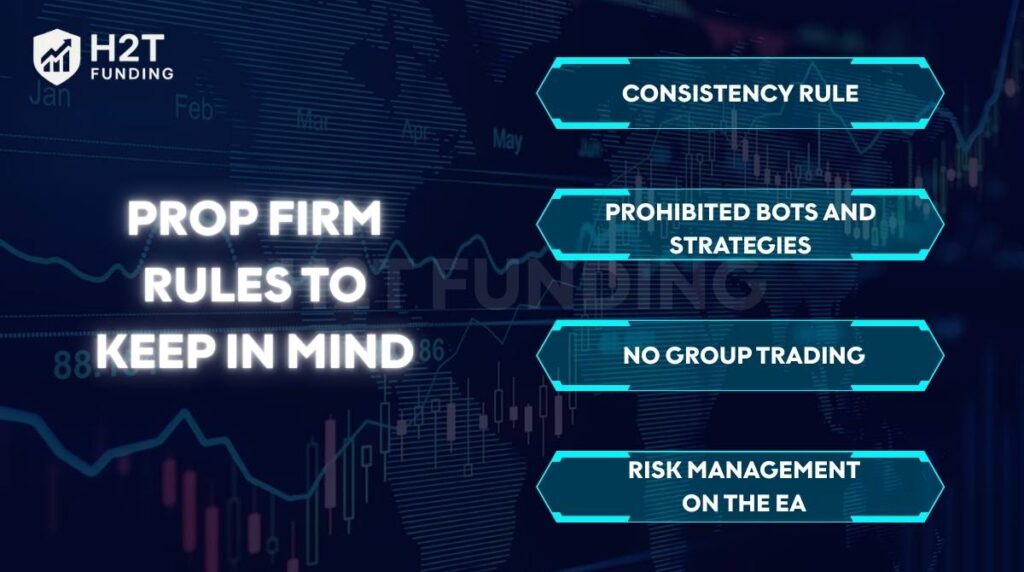
- Consistency Rule: Many firms require your trading to be consistent. This means you cannot suddenly place a single large trade to pass the challenge after a period of small trades. Your lot sizes should be relatively stable.
- Prohibited Bots and Strategies: Nearly all firms ban certain types of automated strategies. These often include latency arbitrage, reverse arbitrage, and hedge arbitrage. Using EAs that copy trades from third-party signals is also frequently disallowed.
- No Group Trading: Coordinating trades with other traders across different accounts to generate artificial profits is strictly forbidden.
- Risk Management on the EA: Any successful MQL5 algorithmic trading prop firm approach must have risk management at its core. This means every trade executed by your EA should have a stop loss. Some firms may even have rules against risking more than a certain percentage (e.g., 2%) on a single trade, which is directly related to understanding what is drawdown in trading.
3. 10 best MQL5 strategies prop firm most
Finding the best strategy for forex trading MT5 in a prop firm context is about balancing profitability with strong capital protection. Below, we explore some of the best forex strategies MQL5 offers and analyze their suitability for prop trading:
- Grid trading strategy
- Trend following strategy
- Scalping strategy
- Martingale strategy
- Breakout trading strategy
- Breakout trading strategy
- Swing trading strategy
- Mean reversion strategy
- Hedging strategy
- Arbitrage strategy
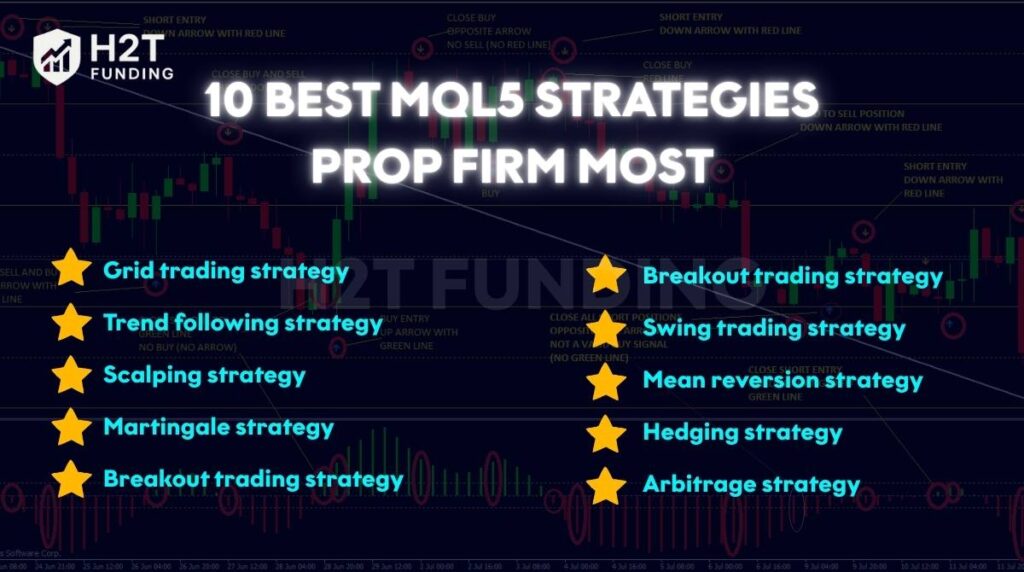
3.1. Grid trading strategy
This Grid trading strategy operates by placing a series of buy and sell orders at predetermined intervals above and below the current price, creating a “grid.” It is designed to profit from markets that are consolidating or trading within a range, capturing small gains as the price oscillates and triggers various orders.
This strategy’s primary cost is not the challenge fee but the risk to your capital. A grid requires a massive capital buffer to survive drawdowns. Spreads and commissions eat into the profitability of each grid level, and slippage during volatile moves can prevent orders from closing at their intended profit targets, worsening the situation.
Example: An EA places buy orders every 20 pips below the price and sell orders every 20 pips above it. It profits from market noise but will face a massive drawdown if a strong, sustained trend appears.
A well-known (though high-risk) commercial example is the Forex Gump EA, which uses a grid-like system. While it can show impressive short-term gains, its underlying grid logic carries the inherent risks mentioned, making it highly unsuitable for prop firms.
| Pros | Cons |
|---|---|
| Profits in a range of markets. | Huge drawdown in trends. |
| Fully automatable. | Violates risk rules. |
| Good for low volatility. | High chance of blowing the account. |
| Generates frequent small gains. | Requires a very large capital buffer. |
3.2. Trend following strategy
It is designed to identify and capitalize on sustained market momentum, aiming to ride a trend for as long as it lasts. This strategy is less sensitive to spreads than scalping, but swap fees (overnight charges) can become a factor for long-term trades. The main “cost” is the psychological patience required and the small losses incurred during choppy market periods.
Example: An EA buys when a 20-period EMA crosses above a 50-period EMA on the H4 chart, signaling an uptrend. It then holds the position with a trailing stop to capture as much of the move as possible. Many successful proprietary EAs are built on this simple logic, often with additional filters like RSI or ADX to avoid ranging markets.
| Pros | Cons |
|---|---|
| Catches large market trends. | Loses money in choppy markets. |
| Simple to automate. | Can enter trends late. |
| Very profitable in trends. | Requires a lot of patience. |
| Disciplined & rule-based. | Prone to false signals. |
3.3. Scalping strategy
Scalping is a high-frequency strategy focused on making dozens or even hundreds of trades per day to capture very small profits from minor price fluctuations. Success is entirely dependent on costs. Low-spread accounts (like Raw or ECN) are mandatory.
Even a 0.5 pip increase in spread can turn a profitable scalping EA into a losing one. Slippage is its biggest enemy, and the cost of a high-quality Virtual Private Server (VPS) located close to the broker’s server is a necessary investment.
Example: On a 1-minute chart, an EA makes dozens of trades to capture tiny profits of just a few pips each. A classic example is the “Hamster Scalping” EA, which often trades during low-volatility night sessions to capitalize on small ranges. Success depends on a high win rate and ultra-fast execution, requiring a VPS.
| Pros | Cons |
|---|---|
| Potential for rapid growth. | Very sensitive to spreads/fees. |
| Many daily opportunities. | High stress and needs monitoring. |
| Low risk on each trade. | Banned by some prop firms. |
| Works in liquid markets. | Slippage can erase profits. |
3.4. Martingale strategy
This strategy involves doubling your trade size after every loss, with the goal of recovering all previous losses plus a profit on the next winning trade. It is an extremely high-risk method and is fundamentally incompatible with prop firm rules.
The challenge fee is almost guaranteed to be lost. This strategy’s exponential lot sizing means it doesn’t just fail; it fails catastrophically. The required capital to theoretically survive a long losing streak is infinite, making it incompatible with the fixed drawdown limits of prop firms.
Example: After a losing trade, the EA doubles the next trade’s lot size. Many commercial EAs secretly incorporate martingale elements. A losing streak quickly leads to huge position sizes that will breach any drawdown limit, making this strategy a ticking time bomb and a guaranteed way to fail a prop firm challenge.
| Pros | Cons |
|---|---|
| Recovers losses on the next win. | Guaranteed to blow accounts. |
| Simple to implement. | Violates drawdown rules. |
| Works well in a range of markets. | Requires huge capital. |
| Can look profitable short term. | Extremely high risk. |
3.5. Breakout trading strategy
Breakout trading strategy is built for speed and volatility, aiming to enter the market just as the price breaks through a key level of support or resistance. The biggest hidden cost is slippage. During a true breakout, volatility is high, and your order may be filled at a much worse price than intended, severely cutting into profits.
Example: An EA places a buy order above a resistance level and a sell order below a support level. When the price breaks through one of these levels, a trade is triggered. Many EAs are designed as “breakout boxes,” automatically placing pending orders around Asian session highs and lows, anticipating a breakout during the London session.
| Pros | Cons |
|---|---|
| Catches fast, powerful moves. | High risk of false breakouts. |
| Works well in volatile markets. | Sensitive to high slippage. |
| Clear entry/exit points. | Can get stopped out early. |
| Easy to automate. | Requires good market timing. |
3.6. News trading strategy
The news trading strategy is a high-risk, high-reward approach that seeks to profit from the massive volatility around major economic news releases. While some traders and EAs can successfully implement this strategy, it’s important to note that many prop firms either prohibit news trading or impose strict conditions to manage risk.
During major news, spreads can widen to 10-20 times their normal level, and slippage can be extreme. An order might be filled dozens of pips away from the entry point. This makes it almost impossible to manage risk effectively and is why most prop firms outright ban trading around high-impact news.
Example: Right before a major news release, an EA places buy and sell orders on both sides of the current price. Specialized EAs for news trading often function by placing straddle orders (a buy stop and a sell stop) moments before a release. When the news causes a price spike, one order is triggered to capture the volatile move.
| Pros | Cons |
|---|---|
| Huge profit potential in seconds. | Extreme risk of slippage. |
| Predictable high-volatility times. | Spreads widen significantly. |
| Clear, event-driven entries. | Often banned by prop firms. |
| Great for automation. | Hard to backtest reliably. |
3.7. Swing trading strategy
This medium-term approach aims to capture larger price “swings” over several days or even weeks, making it well-suited for prop firm challenges that allow more time. Spread and slippage are less of a concern. The primary cost is the swap fee charged for holding positions overnight or over the weekend. On some pairs, these fees can accumulate and significantly reduce the net profit of a trade held for several weeks.
Example: On a 4-hour chart, an EA confirms a clear uptrend. It then waits for the price to pull back to a key support level that coincides with the 50-period moving average. Once a bullish reversal candle forms, the EA enters a long trade.
There are fewer “off-the-shelf” swing trading EAs, as the logic is often more nuanced. However, many successful private EAs are built on this principle, using indicators like RSI to identify oversold/overbought conditions within a larger trend identified on a daily chart.
| Pros | Cons |
|---|---|
| Lower stress than day trading. | Requires a lot of patience. |
| Fewer trades, lower costs. | Risk from overnight gaps. |
| Good risk-to-reward ratios. | Fewer trading opportunities. |
| Works on longer timeframes. | Trades can be in a drawdown for days. |
3.8. Mean reversion strategy
This strategy operates on the statistical principle that prices tend to return to their historical average after an extreme move. It is most effective in reaching markets. While transaction costs are standard, the real financial risk comes from fighting a strong trend.
A single trade that goes wrong because the market doesn’t revert can wipe out dozens of small wins and lead to a drawdown violation. A low minimum lot size is crucial to start small and manage risk.
Example: When the price moves too far from its average (e.g., touching an upper Bollinger Band), the EA sells, betting that the price will return to its mean. Many EAs are built on this principle. A common commercial EA might sell when the price hits the upper Bollinger Band and RSI is above 70, targeting the moving average as a take-profit level.
| Pros | Cons |
|---|---|
| Profitable in a range of markets. | Very dangerous in strong trends. |
| Many trading opportunities. | High risk of large losses. |
| Clear signals from indicators. | Fighting the main trend. |
| Works well with defined ranges. | Requires very strict stop losses. |
3.9. Hedging strategy
Hedging involves opening a position that is opposite to an existing trade to reduce or eliminate risk temporarily. Instead of closing a trade, a trader might open an opposing one to lock in a certain amount of profit or loss. This is a common tactic during periods of high uncertainty, such as a major news release.
The main cost is paying the spread twice (once for the original trade and once for the hedge), which immediately locks in a small loss equal to those costs. Furthermore, many US-based or regulated prop firms adhere to the FIFO (First-In, First-Out) rule, making true hedging impossible.
Example: A trader is in a profitable long position but fears a drop during news. To protect profits, an EA opens an equal-sized short position, neutralizing the risk. Hedging is often done with utility EAs or scripts rather than full-fledged strategies. For example, a “Hedging Panel” EA might allow a trader to instantly open an opposing trade with one click.
| Pros | Cons |
|---|---|
| Protects open profits from volatility. | Stops any further profit potential. |
| Helps hold a core position long-term. | Doubles the transaction costs (spread). |
| Reduces stress during uncertain events. | Not allowed by all prop firms (FIFO). |
| Can “pause” drawdown or lock P/L. | It can complicate decision-making. |
3.10. Arbitrage strategy
This strategy is a purely technological approach, designed to exploit small, fleeting price differences for the same asset across different brokers or liquidity venues. The goal is to simultaneously buy where the price is lower and sell where it is higher, locking in an immediate profit. It is a market-neutral approach that relies purely on execution speed.
This strategy is not viable in a prop firm context. In the institutional world, it requires a massive investment in technology: co-located servers, direct fiber optic connections, and specialized software. The prop firm challenge fee would be the least of the expenses.
Example: An EA detects a small price difference for GOLD between two brokers. It simultaneously buys on the cheaper feed and sells on the more expensive one. Because they are banned, you won’t find successful commercial arbitrage EAs for prop firms. This strategy is strictly banned by prop firms as it exploits technology, not market analysis.
| Pros | Cons |
|---|---|
| Locks in small, low-risk profits. | Banned by almost all prop firms. |
| Not dependent on market direction. | Requires very expensive technology. |
| Potential for a high volume of trades. | Extremely sensitive to execution latency. |
| Requires no market prediction. | Opportunities are rare and vanish instantly. |
4. MT5 tools and features that support prop firm strategy
The MetaTrader 5 platform is packed with features ideal for developing, testing, and running all types of strategies for MetaTrader 5, especially those designed for a funded account.
- MQL5 Strategy Tester: This is your most critical tool. It allows for advanced backtesting and optimization of your Expert Advisors. You can simulate your strategy over years of historical data to see how it would have performed, paying close attention to metrics like maximum drawdown.
- Depth of Market (DOM): The DOM feature provides insights into market liquidity, which can be crucial for strategies sensitive to order execution, like scalping.
- Algorithmic Trading Support: MT5 was built from the ground up to support algorithmic trading. You can run your EA on a Virtual Private Server (VPS) to ensure it operates 24/7 without being affected by your personal computer’s uptime or internet connection.
- Custom Indicators and Scripts: The flexibility of MQL5 allows you to create or commission custom indicators tailored to your unique strategy, giving you an edge in your market analysis.
5. Top MQL5-friendly funding prop firms
Choosing the right prop firm is as critical as designing a profitable strategy. A firm’s rules and technology can either empower your MQL5 Expert Advisor or set it up for failure. You need a partner that not only permits automated trading but also provides a high-quality MT5 infrastructure and maintains transparent, fair rules.
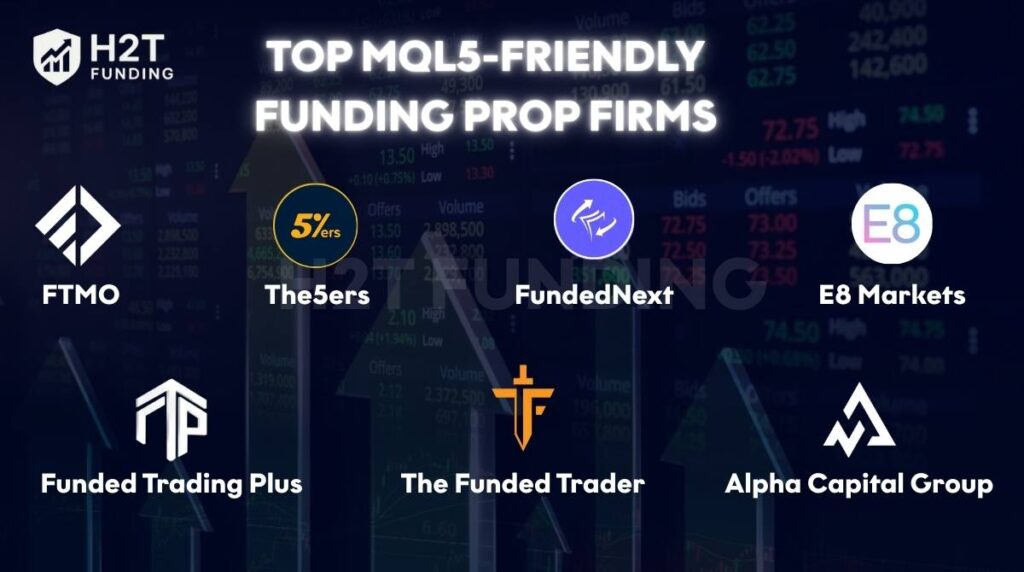
Criteria for selection
When evaluating a prop firm for your MQL5 strategy, consider these key factors in detail:
- EA and algorithmic trading policy: Don’t just look for a “yes” to EAs. Dig into the fine print. Many firms prohibit specific types of automated strategies, such as high-frequency trading (HFT), latency arbitrage, or the use of multi-account trade copiers. Ensure your EA’s logic does not fall into a restricted category.
- MT5 platform and broker quality: The firm must offer the MT5 platform, as MQL5 EAs are not compatible with MT4. Furthermore, investigate the underlying broker. Low spreads, minimal slippage, and fast execution latency are critical for the profitability of most automated strategies, especially scalping and news trading EAs.
- Clear and fair trading rules: The rules must be transparent and conducive to automated trading. Pay close attention to the drawdown type (static vs. trailing), daily loss limits, and any consistency rules. Such rules can penalize an EA for having a single, exceptionally large winning trade compared to its average.
List of recommended prop firms:
Choosing the right prop firm is just as crucial as building an effective MQL5 strategy. The table below compares leading firms based on criteria essential for algorithmic traders.
| Prop Firm Name | EA Allowed? | Permitted EA Types / Requirements | Prohibited Strategies (Common) | Drawdown Conditions (Example) | Profit Target (Example) | Minimum Trading Days |
|---|---|---|---|---|---|---|
| FTMO | Yes | Most EAs are accepted, as long as they comply with risk management rules. | Arbitrage, copy trading from others, and High-Frequency Trading (HFT). | 5% Daily / 10% Max | Phase 1: 10% / Phase 2: 5% | 0 (requirement removed) |
| The5ers | Yes | Very flexible, especially suitable for low-frequency EAs or strategies that need time to develop. | Arbitrage, copying trades from third-party signals. | 5% Daily / 10% Max | Phase 1: 8% / Phase 2: 5% | None |
| FundedNext | Yes | Requires the EA’s strategy to be unique and not a mass-market bot used across many other accounts. | Using an identical EA as others, copy trading, and arbitrage. | 5% Daily / 10% Max | Phase 1: 8% / Phase 2: 5% | 0 (depends on account) |
| Alpha Capital Group | Yes | All EA types are welcome in their stable tech environment. | Arbitrage, copy trading, cross-account martingale strategies. | 5% Daily / 10% Max | Phase 1: 8% / Phase 2: 5% | 0 |
| Funded Trading Plus (FTP) | Yes | Extremely flexible. The lack of time limits is a huge advantage for trend-following or low-frequency EAs. | Arbitrage, server abuse, and copy trading. | 5% Daily / 10% Max | Typically 10% (for 1-phase challenges) | 0 |
| E8 Markets | Yes | Ideal for EAs sensitive to latency and spreads, such as scalping EAs, due to their server technology. | Latency/tick arbitrage, reverse martingale, group copying. | 5% Daily / 8-10% Max (varies) | 8% (for 2-phase challenges) | 0 |
| The Funded Trader (TFT) | Yes | Allows many EA types. The variety of accounts helps traders choose an environment that suits their EA’s risk profile. | Arbitrage, copy trading, and HFT on some accounts. | 5% Daily / 10% Max (Royal account) | Phase 1: 8% / Phase 2: 5% | 0 |
Important Note: This table provides general information for the most common challenge accounts. You must always visit the firm’s official website to confirm the latest rules before participating.
6. Guide to backtesting & optimizing MQL5 strategy for prop firm
Properly testing your MQL5 strategy is the most critical step before risking a challenge fee. The goal is not to find the most profitable settings, but the safest and most consistent ones.
- Run an initial backtest in the MT5 strategy tester: Load your EA into the Strategy Tester and run it on at least one year of historical data for your chosen trading pair. In the settings, focus on the “Every tick based on real ticks” model for the highest accuracy.
- Optimize for drawdown, not just profit: In the “Optimization” tab, select “Complex Criterion Max.” This tells the tester to prioritize settings that yield a good profit factor while keeping the drawdown low. When setting your input ranges for optimization, test different risk parameters like lot size, stop loss, and trailing stop distances.
- Analyze the results: After the optimization finishes, sort the results by the “Complex Criterion” or “Drawdown %.” Look for a cluster of settings that perform well consistently. Avoid “over-optimized” settings that look perfect on one specific dataset but fail under different conditions.
- Forward test on a demo account: Once you have your optimized settings, run the EA on a demo account for at least two to four weeks. This forward test will show you how the EA performs in current market conditions, including real-world factors like spread and slippage. This is the ultimate proof of whether your strategy is viable.
7. Common mistakes when using MQL5 in a prop firm
Many talented traders fail challenges due to easily avoidable mistakes. Be aware of these common pitfalls:
- Abusing martingale or grid systems: As mentioned, these high-risk strategies are a recipe for disaster in a rule-based environment.
- Ignoring spread and slippage: A backtest might look amazing with perfect execution, but in live markets, spread and slippage can significantly degrade performance, especially for scalping EAs.
- Trusting a “Holy Grail” EA: There is no such thing as a perfect, hands-off EA that guarantees a pass. Many EAs sold online are over-optimized for historical data and fail in live conditions. You must always perform your own due diligence and rigorous testing. Ultimate responsibility for risk management always lies with the trader.
8. FAQs
Yes, FTMO allows the use of Expert Advisors (EAs), provided they do not violate their specific trading rules, such as those against latency arbitrage or group copy trading.
There is no single “best” strategy, but the most successful ones prioritize risk management. Low-risk trend following and swing trading strategies are generally well-suited for prop firm rules because they focus on consistent, steady growth and operate well within drawdown limits.
It depends on the firm and the type of scalping. Many firms allow scalping strategies, but they often prohibit “tick scalping” (holding trades for only a few seconds) or high-frequency trading (HFT) EAs. Always check the firm’s specific rules.
The best way is to code risk management directly into the EA. This includes setting a fixed fractional risk per trade (e.g., 0.5% of the account) and a mandatory stop loss for every position. Ideally, it should also have a function that stops the EA for the day if the daily drawdown limit is approaching.
While some may be well-coded, free EAs should be approached with extreme caution. They are often simplistic or may not have the robust risk management features required to pass a prop firm challenge. Thorough backtesting and forward testing are essential.
Absolutely. Many traders successfully use EAs to pass prop firm challenges. Success hinges on selecting or developing an EA specifically designed for the prop firm environment, with a primary focus on capital protection and adherence to rules.
Use the MT5 Strategy Tester with high-quality data and optimize your settings for low drawdown. Afterward, conduct a forward test on a demo account for several weeks to see how it performs in live market conditions.
The best EAs are those built with prop firm rules in mind. They often feature a low-risk approach, avoid prohibited strategies like martingale, and have customizable inputs for risk parameters like daily drawdown limits and max open trades.
Both can work, but a strategy with a high risk-to-reward (R: R) ratio is often more resilient. A strategy with a high R: R can be profitable even with a win rate below 50%, as the winning trades significantly outweigh the losing ones. This can be less stressful than a high-win-rate scalping strategy, where a few unexpected losses can wipe out dozens of winning trades and threaten drawdown limits.
9. Conclusion
Successfully using best MQL5 strategies prop firm to pass a challenge is not about finding a secret algorithm, but about discipline, preparation, and a defense-first mindset. The power of MQL5 and algorithmic trading lies in its ability to execute a well-defined plan flawlessly, removing human emotion and ensuring that every rule is respected.
Choose a suitable strategy, like trend following, and program it with a strict trading rule for capital preservation. By rigorously testing it in the MT5 Strategy Tester, you can build a powerful tool for your trading career. The path to a funded account is paved with smart risk management, and a well-optimized MQL5 EA is one of the best vehicles to get you there.
Now that you have the blueprint for developing a robust strategy, the next step is to find a prop firm that provides the right environment for your EA to thrive. To discover a platform built to support disciplined, algorithmic traders, we invite you to explore the opportunities available at our Prop Firm & Trading Strategies section of H2T Funding.

